Crabs belong to the family of crustaceans and are characterized by their unique body structure, which includes a hard exoskeleton, and ten legs, with two up front that act as claws. They come in various sizes and colors depending on the species but most commonly have a round or oval-shaped shell that protects their vital organs.
Crabs can be found in both saltwater and freshwater environments all over the world, from sandy beaches to rocky shores. They are known for their excellent camouflaging abilities, which allow them to blend into their surroundings with ease.
Apart from being an important part of marine ecosystems as predators or prey, crabs are also consumed by humans as seafood delicacies worldwide. Their meat is considered a delicacy due to its sweet taste and tender texture.
Overall, crabs are fascinating creatures that play an essential role in maintaining ecological balance while also providing nourishment for many people around the globe.
How Many Legs Do Crabs Have?
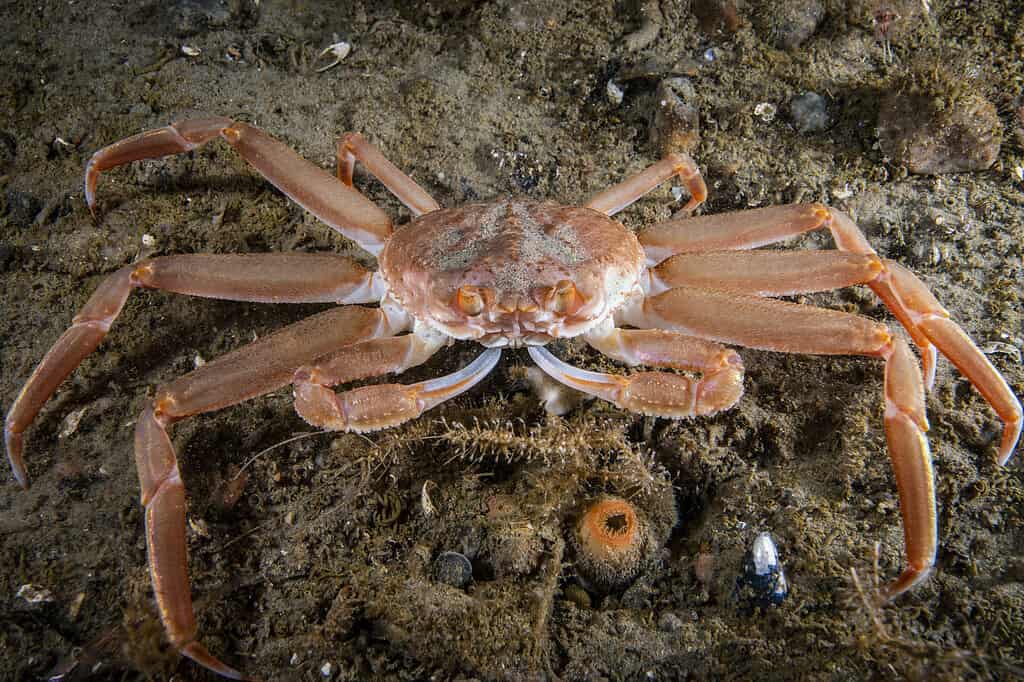
Crabs have 8 walking legs and 2 pincer legs for a total of 10 legs.
©iStock.com/LaSalle-Photo
Crabs are fascinating creatures with unique appearances and distinctive features. One of the most interesting aspects of crabs is their legs. So, exactly how many legs do crabs have? Well, it depends on the species. Most commonly known crabs have ten legs – four pairs of walking legs and one pair of pincers or claws. However, some species of false crabs may have fewer than ten legs. For example, a porcelain grab has eight legs.
The appearance of a crab’s legs varies depending on the type of crab in question. Generally speaking, crab limbs are segmented and jointed appendages that protrude from their bodies’ sides. The front pair – called chelipeds – are usually larger and stronger than the others as they serve to catch prey and defend themselves from predators.
Crab’s walking legs come equipped with small spikes or hairs that provide traction underwater while also aiding in moving through sand or mud when out of its natural habitat near wetlands or coastal areas.
In addition to helping them move around, crabs use their claws for several other purposes such as cracking open shells to reach food inside them, fighting off rivals during mating season, and digging burrows in sandy shorelines where they can hide from predators when necessary.
All in all, these fascinating creatures rely heavily on their numerous appendages for survival – both above water (walking) and below water (swimming).
Interesting Facts About Crabs
A crab’s legs are not the only interesting feature of these wonderful creatures. Here are 14 more awesome facts about crabs!
1. 4500 Species
The vast diversity of crabs is truly astounding, with over 4,500 known species inhabiting the waters and coastlines of our planet. These crustaceans come in a range of shapes and sizes, from tiny miniature crabs that can fit on the tip of your finger to colossal giant spider crabs that span as much as twelve feet across. Some live exclusively in freshwater environments, while others thrive in salty oceans or brackish estuaries.
Despite their differences, all crab species share certain characteristics, such as ten legs (including two specialized claws) and an exoskeleton that provides protection from predators along with structural support for movement and growth. The various adaptations these creatures have developed over millions of years are incredible examples of evolutionary biology at work, reflecting the unique challenges each species faces within its specific habitat. Whether you’re a marine biologist studying these fascinating creatures or simply admiring them from afar during a beach vacation, it’s impossible not to be impressed by the sheer variety and complexity of life found among the many different types of crabs out there.
2. Land and Water
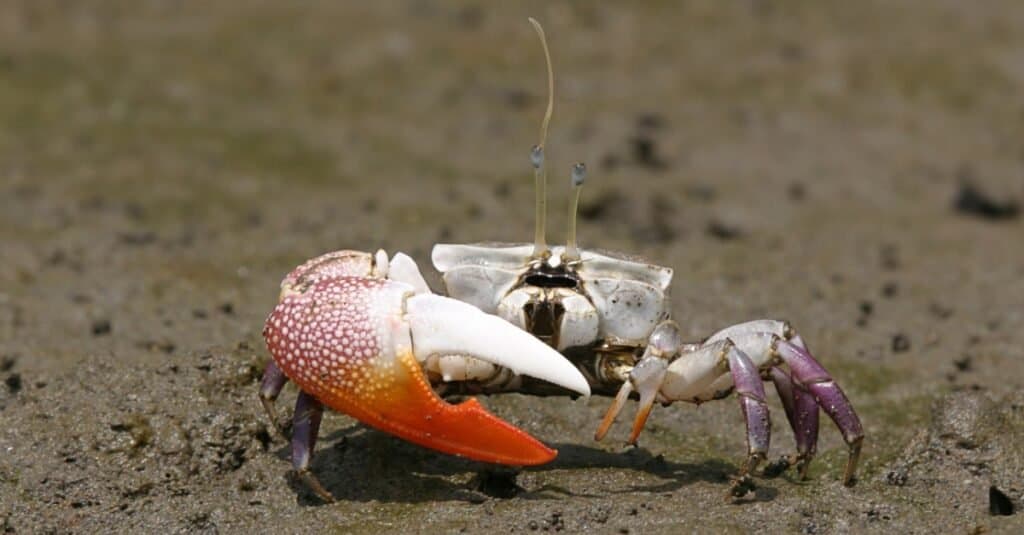
Fiddler crabs can breathe above water or under water.
©iStock.com/craykeeper
Crabs are fascinating creatures that have adapted to live in a wide range of environments, from the depths of the ocean to the sandy beaches and rocky shores along coastlines. Some species of crabs even possess physical characteristics that allow them to thrive on land and water, despite their close genetic relation to prawns and lobsters.
One such example is the fiddler crab, which has developed the ability to breathe using both gills and lungs. This unique adaptation enables these crabs to survive outside of the water as long as they can keep their gills moist. While this may seem like a difficult feat for any creature living primarily on land, fiddler crabs have found ways to stay hydrated by burrowing into damp soil or mud during low tide or rainy weather.
Despite their impressive abilities, not all species of crab are equally adept at surviving on land. In fact, most crabs require constant access to water in order to regulate their body temperature and remain healthy. As a result, many types of crab tend to reside closer inland near freshwater sources rather than venturing too far out onto dry land.
Overall, studying how different species of crab interact with their environment provides valuable insight into how animals adapt over time. Whether living underwater or on land, each type of crab has evolved its own set of unique traits that enable it to survive and thrive in its particular niche within the ecosystem.
3. In Every Ocean
Crabs are one of the most widespread and adaptable creatures on earth, found in every ocean across the globe. While some species prefer to live in coastal areas with salty water, others thrive in freshwater environments or a combination of both called brackish water. These crustaceans have evolved over millions of years to adapt to their unique habitats and can be found scurrying along sandy beaches, hiding amongst rocks, or even burrowing into mud flats. Despite their different habitats, all crabs share certain characteristics like their distinctive exoskeletons and ten-legged bodies that make them easily recognizable.
4. 200 Million Years Old
Crabs are one of the oldest living creatures on Earth, dating back to the Jurassic period 200 million years ago. Their evolutionary history is fascinating and complex, with many different species evolving and adapting over time. One key aspect of crab evolution is their unique anatomy, which includes a hard outer shell for protection and specialized claws for hunting and defense. Over time, crabs have also developed a variety of different feeding strategies, from scavenging to predation. Despite their ancient origins, however, crabs continue to thrive today in a wide range of habitats around the world.
5. .27 Inches Long
The pea crab, the smallest known species of crab, is a tiny creature measuring between 0.27 and 0.48 inches long. Despite its small size, it has adapted to survive in various environments such as coral reefs, oyster beds, and sea anemones. Found all over the world’s oceans, these crabs are known for their bright colors which help them blend into their surroundings and avoid predators. They also have unique adaptations like specialized claws that allow them to hold onto hosts or prey while they feed on bits of food left behind by larger creatures. Overall, this miniature marvel is an important part of marine ecosystems and a testament to the incredible diversity found in our oceans!
6. 12 Feet Long
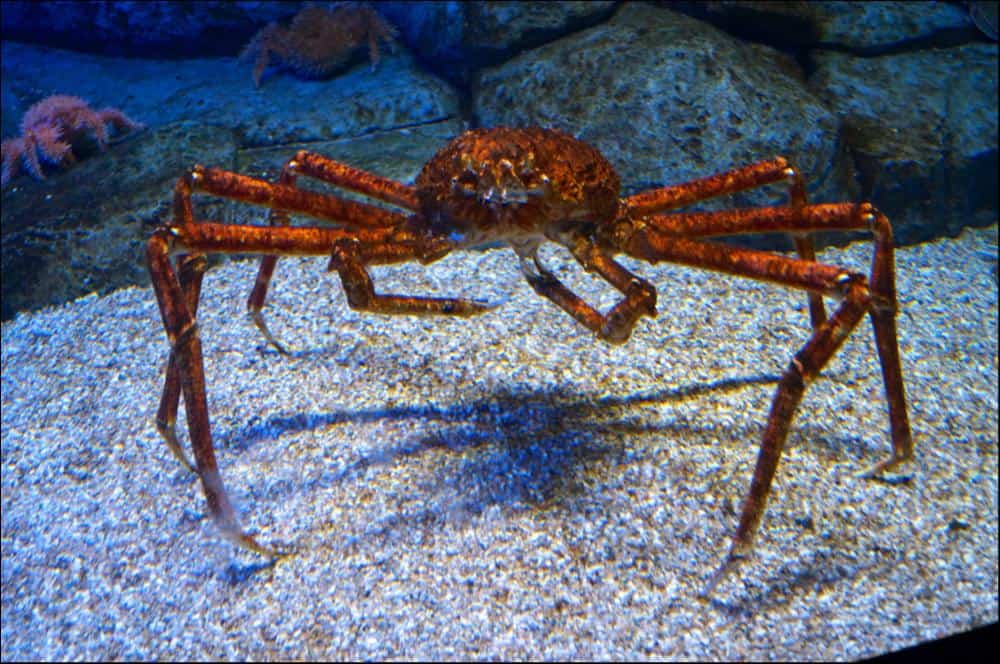
Spider crabs can be 12 feet long if measured from the end of one leg to another.
©StuVidiot/Shutterstock.com
The Japanese spider crab, also known as Macrocheira kaempferi, is the largest crab species in the world and can measure up to 12 feet from claw to claw. These crabs are found in the waters surrounding Japan and have a brownish-red color with white spots on their shells. They are omnivorous and feed on small fish, mollusks, algae, and even dead animals. Due to overfishing and habitat destruction, this species is currently listed as vulnerable by the International Union for Conservation of Nature (IUCN).
7. Exoskeletons
Crabs, like other arthropods, have an exoskeleton made of chitin that serves as a protective outer layer for their soft tissue. This exoskeleton is composed of multiple layers and provides structural support for the crab’s body while also serving as a barrier against predators and environmental challenges. As the crab grows, it sheds its old exoskeleton through a process called molting and produces a new one to accommodate its increasing size. The chitinous composition of the exoskeleton is what gives crabs their characteristic hard exterior and makes them unique creatures in the animal kingdom.
8. Walking and Swimming Sideways
Crabs have a unique way of moving that sets them apart from other creatures. Their legs are positioned in such a way that they can only move sideways, making them ideal for navigating the rocky terrain of the ocean floor. This also allows them to quickly change direction and evade predators. When it comes to swimming, crabs use their back legs like paddles to propel themselves through the water in a graceful motion. Overall, this distinctive form of locomotion is one of the many fascinating aspects of these intriguing creatures.
9. Omnivorous
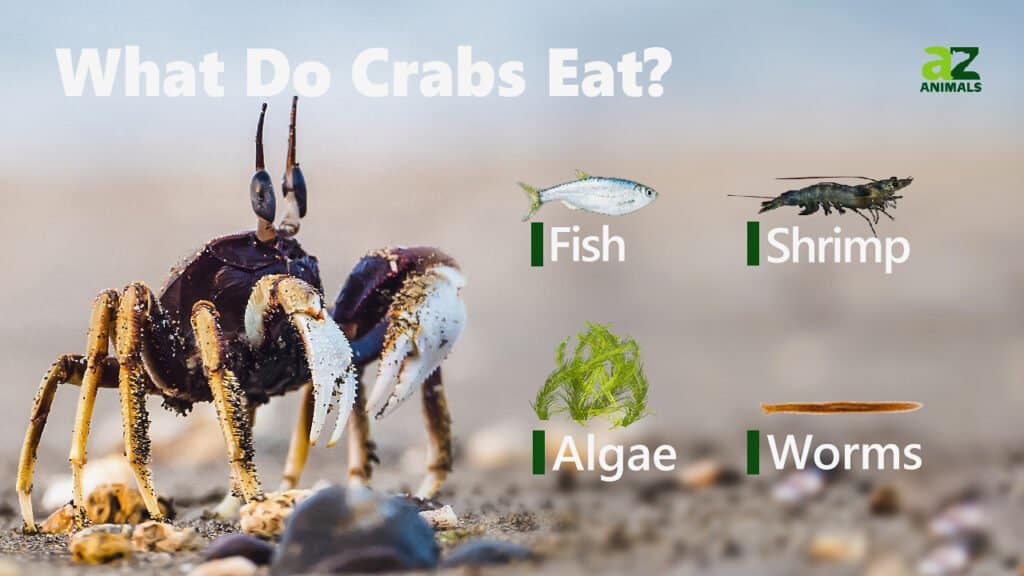
Crabs are known for their omnivorous diet, which means they consume both meat and plants. These scavengers feed on a wide variety of food sources including fish, mollusks, clams, algae, seaweed, plankton, and even detritus – dead organic matter that settles at the bottom of water bodies.
Their feeding habits depend on various factors such as habitat availability and seasonality. In general, crabs tend to prefer feeding during low tide when prey is more accessible. They use their sharp claws to catch small animals or tear apart larger ones into smaller pieces.
Some species like the blue crab have a strong preference for certain foods such as oysters and mussels while others like the Dungeness crab will eat almost anything they find edible. Crustaceans also have an amazing capacity to adapt their diets based on what’s available in their environment.
In addition to being important predators within marine ecosystems, crabs also play an important role in nutrient cycling by consuming decomposing organic material and recycling it back into the ecosystem. This makes them critical components of healthy coastal environments.
10. 2,000 Eggs!
Crab reproduction is an interesting and complex process that involves multiple stages. Female crabs typically reach sexual maturity within the first two to three years of their life, while male crabs take slightly longer to mature. Once a female crab is ready to reproduce, she will mate with a male crab by either attracting him with pheromones or through direct contact.
During mating, the male crab transfers his sperm into the female’s seminal receptacle using specialized appendages called gonopods. The fertilized eggs are then carried inside the female’s abdomen for several days before being released into the water in a mass known as a sponge. This sponge contains anywhere from 1,000 to 2,000 eggs depending on the species of crab.
After being released from the mother’s body, these eggs hatch into tiny larvae known as zoea which float around in ocean currents until they grow large enough to settle onto solid surfaces such as rocks or other substrates. As they continue to develop and molt over time, they eventually become juvenile crabs which resemble smaller versions of adult crabs.
11. A Group of Crabs
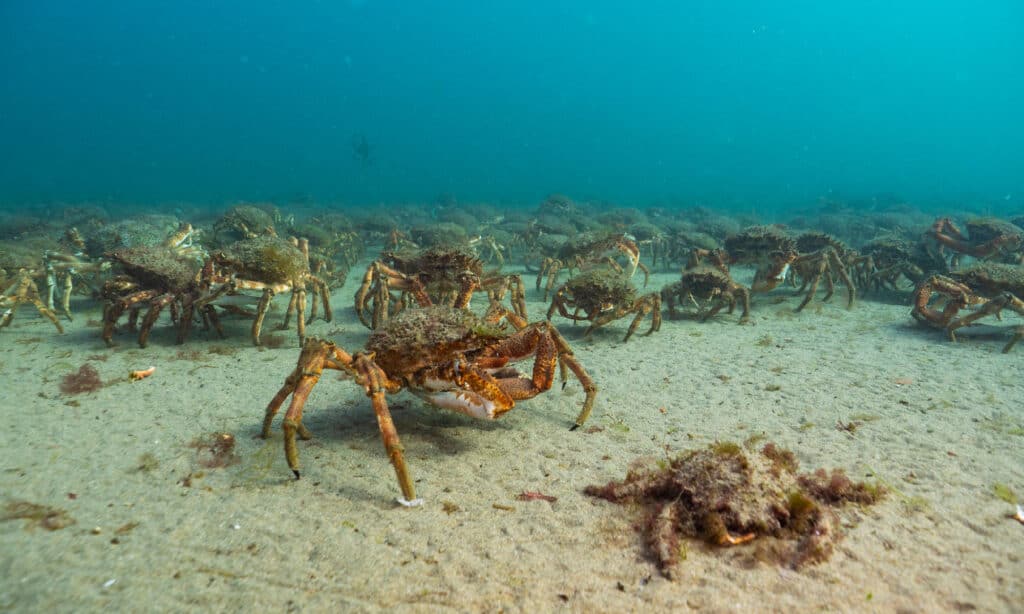
Some types of crabs are social and some are solitary creatures.
©iStock.com/Jake Davies
Some types of crabs are social creatures that live in groups known as “casts.” These casts can range from just a few individuals to hundreds or even thousands of crabs. Living together in this way allows the crabs to protect themselves from predators, find food more easily, and mate with one another. In some species, such as fiddler crabs, these casts are divided into territories controlled by individual males who use their large claws to defend their space and attract mates. Crabs have evolved many different ways of communicating with one another within these groups, including chemical signals and visual displays.
12. Flat Bodies
The flat bodies of crabs are a unique adaptation that allows them to navigate through tight spaces with ease. This feature is particularly useful for species that live in rocky or coral habitats, where they may need to hide from predators or find shelter during high tides. By flattening their bodies, crabs can reduce their surface area and squeeze into narrow crevices without getting stuck. Additionally, some species have specialized appendages, such as flattened legs or claws, which help them grip surfaces while maneuvering in confined spaces. Overall, the ability to flatten their bodies gives crabs greater flexibility and enhances their survival strategies in challenging environments.
13. False Crabs

Hermit crabs are false crabs
©Lauren Suryanata/Shutterstock.com
Crabs are fascinating creatures that come in many different shapes and sizes. In fact, there are two distinct types of crabs: true crabs and false crabs. True crabs, also known as brachyurans, have very short abdomens and use four pairs of long legs for walking and two for pinching, for a total of 10 crab legs. This gives them a distinctive look that is instantly recognizable to anyone who has ever seen one scuttle along the beach or ocean floor.
Some examples of true crabs include blue crabs, spider crabs, and ghost crabs. Blue crab is one of the most popular species among seafood lovers due to their sweet meat flavor. Spider crab’s elongated body provides camouflage while they walk on seaweed-covered rocks or sandy bottoms with ease using their sharp claws which can be up to 10 inches long! Meanwhile, ghost crabs are known for their speed – they can run up to 10 miles per hour!
False crabs, on the other hand, which fall under the category of anomurans have a longer abdominal section with fewer walking legs compared to true ones. Though this may make them appear less “crab-like” than their counterparts at first glance these creatures still share several similarities with true ones such as having hard exoskeletons covering their bodies.
Examples of false crab species include hermit crabs which are commonly found inhabiting empty shells from other animals like snails or clams and the king crab.
14. Amazing Crab Vision
Crab eyes are a fascinating feature of these crustaceans. They possess large compound eyes that are composed of hundreds of tiny lenses, each with its own cornea and crystalline cone. These lenses work together to create a mosaic image for the crab, allowing it to see in almost every direction at once.
This visual system is incredibly sophisticated and efficient, as it allows crabs to detect even the slightest movements and changes in their environment. Furthermore, some species have evolved specialized adaptations in their eyes to help them navigate different habitats or find prey more effectively.
For example, many deep-sea crabs have developed larger pupils and more sensitive photoreceptors to maximize their ability to detect bioluminescent creatures living at great depths. Other species might have flattened lenses that allow them to better perceive objects on the seafloor or in murky waters.
The photo featured at the top of this post is © iStock.com/ANDREYGUDKOV
Thank you for reading! Have some feedback for us? Contact the AZ Animals editorial team.






